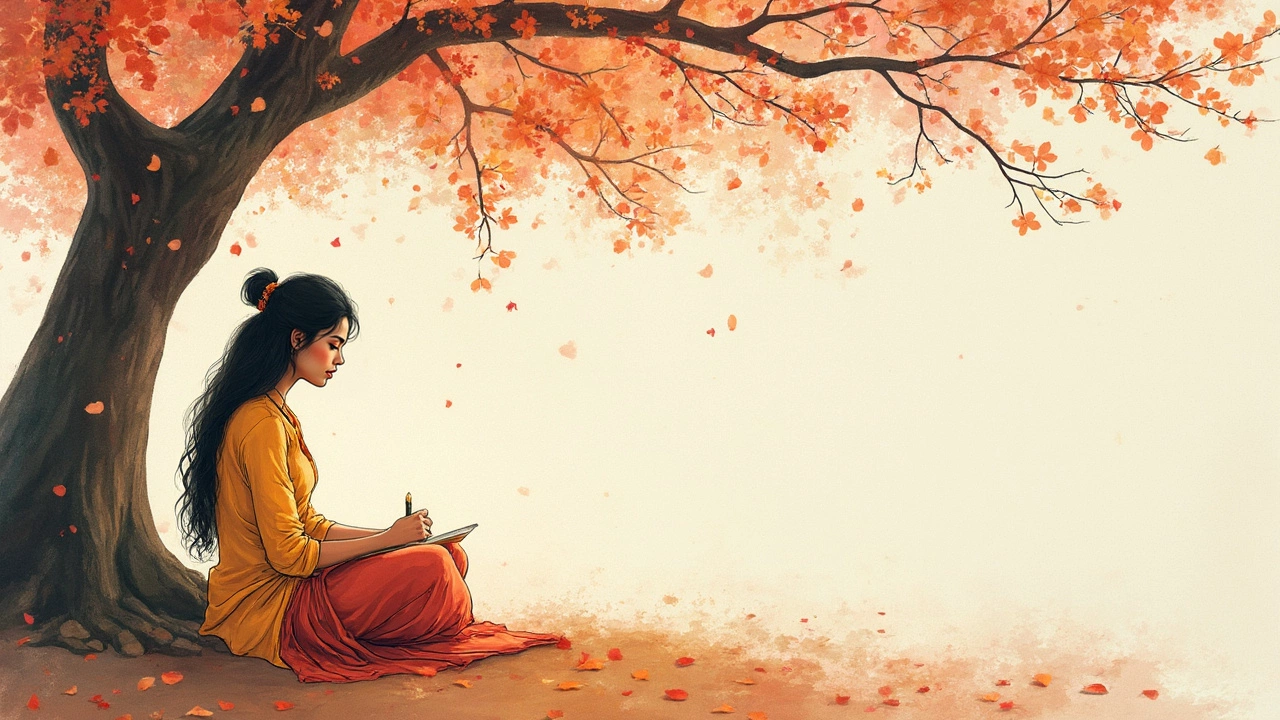Three-Line Poems Explained: Discover the Art and Types of Short Poetry

Trying to say everything you want in just three lines can feel like catching lightning in a bottle. Some of the world’s most famous poetry stretches on for pages, yet a tiny three-liner can jab you in the heart or make you laugh out loud with just a handful of words. So what do you call a three-line poem? Get ready for a surprising ride through the world of the poetry sprint—where fewer words punch harder, images pop sharply, and history, philosophy, and nature collide in just three beats.
Understanding the Basics: What is a Three-Line Poem?
Ask someone on the street, and you’ll probably get "haiku" as the first answer. But that’s just the most famous type. The three-line poem is a structure, not a single poem with only one rule. The proper umbrella name for any poem with three lines is “tercet.” Simple, right? Well, sort of. The tercet itself isn’t fussy about syllables or rhyme. All it needs is three lines, and it doesn’t care if you want to rhyme them, count their beats, or let them float free like day-old balloons.
The history of the tercet runs deep. It pops up in medieval Italian poetry, makes guest appearances in Persian classics, and shows up in poems from around the globe. Italian poets, especially Dante, loved playing with terza rima—a chain of tercets that snake through a poem with a linking rhyme. Think of tercets like three-legged stools: sturdy, basic, and everywhere. Some writers toss in rhyme, some don’t. They can be standalone or stacked up, creating longer poems that feel like quick-fire bits of wisdom or snapshots of a scene.
So yes, if a poem has three lines, you can call it a tercet. But the real fun is in the details—how writers bend and break the structure to fit their voice or culture. The shape invites creativity, not restriction. You’re given a box and told, “Fill it with whatever you want, but only three things.”
Diving Deeper: Famous Types of Three-Line Poems
Everyone knows about the haiku—that Japanese classic. With its tight 5-7-5 syllable rule, it challenges even seasoned writers to say something big with almost nothing. But haiku are just one flavor. There's also the senryu, which swaps nature's cherry blossoms for the quirks of human life. Both forms look the same at a glance, but a haiku will paint you a picture of the mountains at dawn; a senryu might joke about your neighbor's strange habits.
Western poets also tinker with the three-line game. Take the triplet. It's a tercet where all three lines rhyme. Dr. Seuss made a meal of this kind of rhyme-mad poetry, though his stuff often runs longer than three lines. The villanelle—a whole different beast—is built from alternating tercets, save for the last line. You get the feeling poets just can't say "no" to the three-line challenge.
Have you ever heard of the katauta from Japan? It's a tiny poem often used as a question, structured in three lines with 5-7-7 syllables. Or the Italian terza rima used in Dante's Divine Comedy, where interlocking rhyme binds one tercet to the next? These shapes make the poem memorable. UK poet Wendy Cope is famous for using playful, tight forms—including three-liners—that stick in your head.
| Type | Origin | Typical Structure | Main Focus |
|---|---|---|---|
| Haiku | Japan | 5-7-5 syllables, no rhyme | Nature / Seasons |
| Senryu | Japan | 5-7-5 syllables, no rhyme | Human nature |
| Katauta | Japan | 5-7-7 syllables, question-form | Personal / Philosophical |
| Triplet | English | Three lines, all rhyme | Open |
| Terza Rima | Italy | Three lines, interlocking rhyme (aba bcb cdc...) | Epics / Long Narrative poems |
Each form can orbit its own themes, but the three-line rule creates a certain urgency. Every word matters. No place for fluff. It’s like Twitter, before the character count got more generous—only, it’s survived for centuries because poets just like how tough it is to squeeze magic out of a small box.

Why Write or Read Three-Line Poems?
If you’ve tried to squeeze a big idea into a small text before your coffee’s kicked in, you know the pain poets feel. The discipline of the form is the challenge. Three lines mean you can’t hide. Every sound, every pause matters. Writing these poems is training for precision and economy of expression. Want to improve your writing, even if you’re not a poet? Practice three-liners. Nobel-winning poet Ryoichi Wago wrote over 500 haiku about the Fukushima disaster, squeezed between train commutes. Those poems stunned the world with their simplicity—that's the punch a three-liner can pack.
Readers love them for the exact same reasons. They’re snackable. In a world that scrolls and swipes, you can read a dozen on your commute or savor just one and roll the words around in your head for days. They’re portable, shareable, and perfect for social media (plus, easy on the eyes compared to a massive wall of text). Thousands of people share daily haiku on Instagram and Twitter—just search #haiku or #tercet and scroll through a treasure trove of quick insights and sharp images.
These poems are also great for people learning English or another new language. The limited word count makes them less intimidating to write, but demands you pick just the right word to click with the reader. Teachers have used haiku to help students pay attention to the world around them, from the sound of rain to the taste of fresh bread. You don’t need to be Shakespeare. You just need two eyes, an honest voice, and the courage to risk sounding silly every once in a while.
Ever tried to write a love poem without sounding cheesy? Try it in three lines. Suddenly every word counts. Suddenly, “I love you” becomes a world, not a cliche. Some of the best three-liners don’t even rhyme, but they stick. They last because they're natural, not forced. This is a poetry form for people who like a good challenge—there’s no time for fluff or fake sentiment. Only the real thing survives in three lines.
How to Master the Three-Line Poem: Practical Tips & Fun Experiments
Ready to try your hand? Writing a three-line poem might sound simple, but it’s earned a legendary reputation for being tough. Start with a topic—a leaf on your morning walk, your cat’s dramatic return from the rain, a headline that made you think. Don’t fuss about making it perfect at first. Sketch out the image or idea in three rough lines. Read them aloud. Hear the rhythm? Tweak until it sounds right in your mouth and your mind.
- If you’re writing a haiku, stick to 5-7-5 syllables. That’s five in the first line, seven in the second, five in the last. Don’t add filler words just to hit the count—make each syllable work for you. Classic haiku focus on nature but don’t have to. Try writing one late at night, staring at your messy kitchen. You might surprise yourself.
- Senryu open up the field—use humor, irony, or observations about family, work, love, or daily annoyances. There’s no hard rule, so follow the feeling and the moment.
- Want to play with rhyme? Craft a triplet. Make the lines bounce off each other, or let them clash. Rhyme “cat,” “mat,” “hat”—then flip the final line for a twist.
- Use a tercet as a stanza in a longer poem. Stack them, borrow from terza rima, and see if you can stitch together a story or mood that carries across the breaks.
Here’s a tip: Keep a notebook or your phone handy. Three lines can happen in a flash—waiting for your coffee, watching the sun set from your porch. Jot them down and look for the line or image that sparks. If you want some pressure, join an online group or challenge. There’s even a “National Haiku Writing Month” every February, where participants write one haiku each day. You’ll get feedback, inspiration, and sometimes friendly competition—nothing like a deadline to keep your brain on its toes.
Don’t stress about “rules” too much. Some of today’s most celebrated three-liners break away from strict syllable counts or perfect rhyme. Try not to overthink. Simple language works best. If your three-liner paints a clear picture or leaves someone feeling something new, it’s doing its job. That’s why, across centuries and continents, the three-line poem keeps showing up. Short, sharp bursts of poetry are here to stay, as long as there are things worth noticing, questions worth asking, and feelings worth sharing—in just three lines.